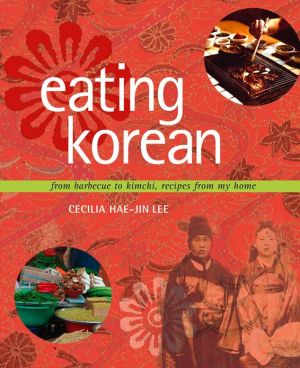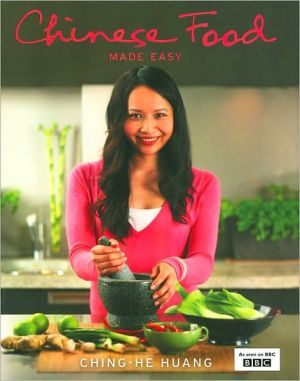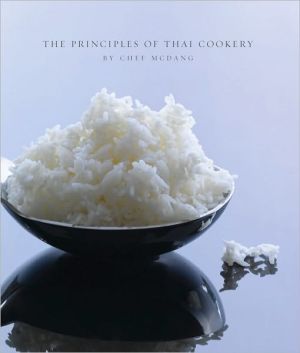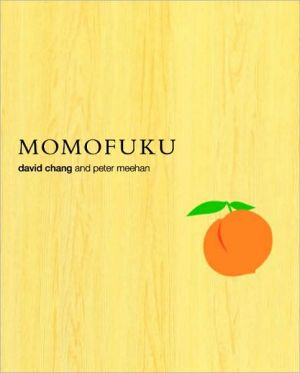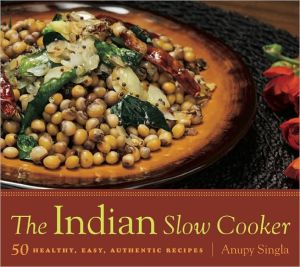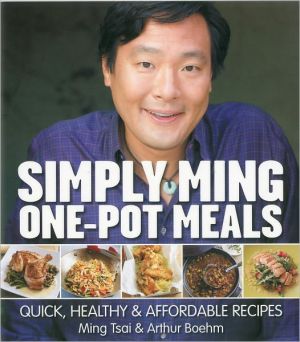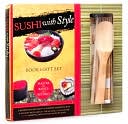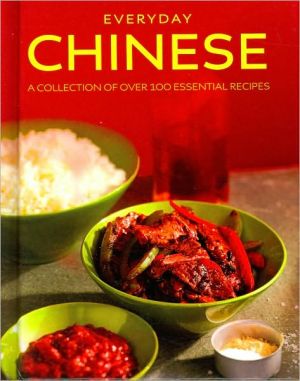Eating Korean: From Barbeque to Kimchi, Recipes From My Home
Experience the savory secrets of the "other" Asian cuisine\ In Eating Korean, the gifted food writer and award-winning chef Cecilia Hae Jin-Lee invites us to join her in discovering the unique cuisine and culture of her native land. Pairing delectable, authentic recipes with personal recollections and details on Korean traditions, Eating Korean offers an accessible and tempting introduction to the fresh and flavorful world of Korean cooking.\ "Cecilia's stories remind me of my childhood. You...
Search in google:
From aromatic hot pots to piquant kimchi (pickled cabbage) to classic bibim bap (rice bowls), Korean cuisine's exhilarating harmony of robust flavors, colors, and textures spices up any meal. And though Korean is an increasingly popular dining-out option, few people venture to explore the peninsula's rich culinary arts at home. In Eating Korean, Cecilia Hae-Jin Lee invites us into her family kitchen to reveal the secrets—and the surprising simplicity—of the "other" Asian cuisine. This warm, evocative celebration of Korean food features more than 100 authentic recipes alongside fascinating historical morsels and personal remembrances. Lee's passion for the foods of her native land is rendered vividly in reminiscences—of early morning mountain hikes followed by soothing chicken soup with rice, or the cozy hum of activity in her mother's kitchen before a celebration—that bring Korean cuisine richly to life.These enchanting narratives are the perfect prelude to the dishes themselves: the fragrant medley of Seafood Hot Pot, the intensely spiced Fire Meat, the scrumptious nuttiness of Sweet Spiced Rice, and a host of others. The dishes here cover all parts of the Korean menu—rice specialties; soups and hot pots; seafood, meat, and poultry dishes; desserts and snacks; side dishes; and more.Eating Korean reveals how delightfully easy Korean dishes can be to prepare at home. Many hot pots and soups, for instance, can be on the table in less than half an hour of cooking time. Spicy, flavor-rich marinades, made with just a handful of ingredients, offer deliciously simple alternatives for barbecuing chicken, beef, and ribs. Quick, trouble-free preparations make the dishes in these pages ideal for any meal, from family dinner to holiday feast. The fact that Korean ranks among the world's healthiest cuisines makes it even more enticing—and not just for special occasions.Lee also offers illuminating insight into Korean eating traditions—etiquette, essential foods, and key ingredients. A full chapter is devoted to the customs and foods of holidays and celebrations, including New Year, Harvest Festival, birthdays, and weddings. The book's 65 photographs and illustrations—of Korea's food markets and countryside, its bountiful tables and traditional celebrations—round out this captivating portrait.In its beguiling presentation of a cuisine and culture that are at once wonderfully exotic and remarkably accessible, Eating Korean inspires us to explore the eye-catching, mouthwatering delights of the Korean table in our own kitchens. The New York Times - Corby Kummer ecilia Hae-Jin Lee, who moved from Seoul to Los Angeles when she was a child, writes vivaciously about working in her father's grocery store and hanging out in her mother's endlessly active kitchen. Her stories will inspire you to put up gallons of kimchi (try the cucumber) and flip dozens of green-onion pancakes.
Eating Korean\ \ By Cecilia Hae-Jin Lee \ John Wiley & Sons\ ISBN: 0-7645-4078-5 \ \ \ Chapter One\ Basics\ SEED BEARERS\ My family has grown Korean vegetables on American soil ever since we bought our first small house back in the early eighties. A visitor would bring mysterious seeds from the homeland; during spring, the seeds would be planted into the fertile soil. By the time summer rolled around, the backyard would be teeming with squash vines coiling everywhere, lush green pepper plants or garlic stalks whose tall stems would burst forth with beautiful, garlic-smelling flowers. Any houseplant or cactus given to my mom as a gift from her offspring would eventually be killed, yet for some crazy reason, the vegetables in our backyard thrived under her care. I guess my dad did most of the complicated stuff-the planting, the weeding. My mom was there to enjoy the fruits of the harvest, when the plants were ready for the dinner table. My folks redefined the idea of an "open door" policy. People came in and out of our house any time of year. Invariably, the visitors would have to sleep in either my brother's room or the room my sister and I shared. All of us spent half of our growing-up years sleeping on the living room floor. It didn't help that we had family trees that extended beyond mere branches on both sides. My dad was the eighth son of sixteen children (fourteen boys). In fact, his name, Pal-Woo, means "eight" and "plentiful rain," a symbol of good fortune in the rural communitywhere he grew up. My mom was the eldest of a mere five children, but relatives expanded several generations both up and down her side of the family.\ Summers were the most hectic. Vacationing cousins sprawled out comfortably on our beds, while we and our younger friends would sleep on blankets in the living room. Whispered conversations and quiet giggles would reverberate throughout the dark house as we waited for the sound of snoring to emanate from behind my folks' bedroom door. Too hot and excited to sleep, we would turn on the TV with the volume just barely audible over the sound of warm weather insects. Surreptitiously, we'd catch the latest music videos or some late-night B-movie as we snuck food my dad was saving for anju (drinking snacks). Sometimes there would be some static on TV screwing up our late-night revelry and my sister and I would try to coax our little brother into walking the two feet required to adjust the antenna, too lazy to move our own sleepy-time selves. When we got tired of whatever was on the tube, we'd play silly games or tell ghost stories well into the wee hours, until we fell asleep accidentally only to wake up with an imprint of a Monopoly game piece on one of our cheeks.\ During waking hours, the house would be bustling with activity. Someone was always banging on the bathroom door to tell someone else to hurry, while people ran back and forth chasing each other. It seemed as if someone else was always cooking something, doing the dishes, or eating. It was nonstop action in the kitchen.\ This past year, my parents had visitors from several states. They've housed half a dozen priests from all over the world, nieces from three continents, and even an amateur Russian dance troupe-young Korean girls whose grandparents were forced to immigrate to Siberia during Stalin's Reign of Terror.\ While their house was abuzz with activity, the garden quietly produced lettuce, peppers, Asian radishes, perilla leaves, and cucumbers. One of their well-meaning friends picked the last cucumbers they were saving for seed. With her usual good nature, my mom just laughed and sent someone else out for more peppers and lettuce to eat with the last cucumbers of the season, while I made Seasoned Fermented Soybean Paste (yangnyum dwenjang) for dipping. Soon enough, we were all sitting around the dining table, chatting and snacking away on fresh vegetables from the garden.\ Next year will bring more visitors. The seeds they bring will be planted. The people will come and go. The vegetables will grow and die. And the cycle will continue like the revolving door of our lives.\ Toasted Sesame Seeds\ Ggae\ Sesame seeds are one of the major staples of Korean cooking. Although you can buy seeds already toasted, the flavor is much better when you toast the seeds yourself. It's easy to do, and toasting them brings out the wonderful nutty flavor. They will keep for months in an airtight container in the fridge, but keep even longer in the freezer. MAKES 1 CUP\ 1 cup sesame seeds\ 1 Place the seeds in a heavy skillet over a very low flame.\ With a wooden spoon or spatula, stir the sesame seeds until they turn a dark golden brown. Take care since the seeds will occasionally pop in the pan during toasting.\ 2 Remove from heat and allow the seeds to cool to room temperature. Store in an airtight container in the refrigerator or freezer.\ VARIATION: You may wish to crush the seeds before storing for use in certain recipes. Use a mortar and pestle, a blender, or a food processor to crush the seeds. Sesame seeds stored in the refrigerator or freezer will have a longer shelf life.\ Seasoned Soy Sauce\ Yangnyum Ganjang\ A popular dipping sauce, it can also be used for seasoning vegetables, fish, and meat. It also makes a nice accompaniment to some noodle dishes. MAKES 1/2 CUP\ 4 tablespoons soy sauce 1 green onion, finely chopped 2 garlic cloves, minced 1 tablespoon toasted sesame seeds (page 3) 1 tablespoon sesame oil 1/2 tablespoon chili powder 1/2 teaspoon black pepper (optional)\ 1 Combine all ingredients in a small bowl.\ 2 If serving as a dipping sauce, serve in small individual bowls. Leftovers can be stored in the refrigerator in a tightly sealed container for about a week.\ Vinegar Soy Sauce\ Cho Ganjang\ Another popular dipping sauce, it is usually served with dumplings and other dishes. MAKES 1/2 CUP\ 2 tablespoons soy sauce 2 tablespoons rice vinegar or white vinegar 1 tablespoon sesame oil 1 tablespoon toasted sesame seeds (page 3) 1 teaspoon black pepper (optional)\ 1 Combine all ingredients in a small bowl.\ 2 For dipping, serve in individual small dishes. Store leftovers in a tightly sealed container for about a week.\ Seasoned Fermented Soybean Paste\ Yangnyum Dwenjang\ This sauce can be served as a dipping sauce for fresh vegetables such as cucumbers, Korean green peppers, and carrots. It's also served on the side to eat with rice and grilled meats wrapped in lettuce or perilla leaves. MAKES 1/2 CUP\ 4 tablespoons fermented soybean paste (dwenjang) 2 garlic cloves, minced 1 green onion, chopped 2 tablespoons sesame oil\ 1 Combine all ingredients until they are well mixed.\ 2 Serve in small individual-sized bowls. When stored in a covered container, this paste will keep in the refrigerator for about a week.\ Fresh Red Chili Sauce\ Put Gochujang\ Made with fresh peppers or chili powder, this is a chili paste that doesn't require fermentation. It's used as a seasoning for certain soups and noodles. MAKES ABOUT 1 CUP\ 5 garlic cloves 10 red Korean chile peppers, coarsely chopped or 1 cup chili powder 1/4 cup sesame oil 1/4 cup vegetable oil\ 1 With a mortar and pestle, mash the garlic well. If you don't have a mortar and pestle, use a blender or food processor. Add the chile peppers or chili powder and pound (or grind) into a paste.\ 2 Transfer into a bowl and add the oils, mixing until it becomes a coarse paste. Transfer into a glass jar with a tight lid and store in the fridge indefinitely.\ Red Chili Paste\ Gochujang\ Hardly anyone makes their own red chili paste at home, since such delicious varieties are readily available in grocery stores. However, if you want the wonderful taste of homemade, it's not that hard to make. It just takes a little bit of time to get it to ferment properly. This spicy chili paste is a staple in Korean cooking and there is really no substitute for it. You will need a well-cleaned, medium-sized glass or clay jar (hang ali) with a tightly fitting lid. MAKES 4 CUPS\ 1 1/2 cups fine barley malt powder (yut gilum) Water 2 cups sweet rice flour 2 cups red chili powder 1 cup fine soybean malt powder (meju galu) 1 cup coarse sea salt 1/2 cup soy sauce\ 1 In a bowl, combine barley malt powder and 5 cups water (preferably filtered) and stir until powder is completely dissolved. Let stand overnight in a warm place or in an electric rice cooker. Strain into a heavy stockpot. Add sweet rice flour and stir until dissolved. Bring to a boil and simmer uncovered over low heat for about 20 minutes, until its volume is reduced by a third or a half. Cool and set aside.\ 2 In a large bowl, combine chili powder, soybean malt powder, rice flour and malt mixture, 1/4 cup of the salt, and the soy sauce. Mix thoroughly with a wooden spoon. Let stand overnight.\ 3 Transfer the chili paste to the jar and sprinkle the remaining 3/4 cup of salt on top. Leave some space on top of the jar, because the mixture will rise as it ferments. Cover with cheesecloth or some other breathable fabric. Sun-dry every day and cover at night. It may be used right away but for best results, let the chili paste mature for at least a month. Afterward, store in a tightly sealed container in the fridge and it will keep indefinitely.\ Seasoned Chili Paste\ Yangnyum Gochujang\ Used to season such dishes as Mixed Rice Bowl (Bibim Bap, recipe page 23), Yangnyum Gochujang can also be served as a dipping sauce for fresh vegetables such as cucumbers, Korean green peppers, and carrots. The spiciness of the sauce will depend on how hot the gochujang is. MAKES 1/2 CUP\ 4 tablespoons chili paste (gochujang) 2 garlic cloves, minced 2 tablespoons sesame oil 1 tablespoon soy sauce 2 teaspoons sugar or Korean malt syrup (mool yut) 2 teaspoons toasted sesame seeds (page 3), optional 1 green onion, chopped (optional)\ 1 Combine all ingredients until they are well mixed.\ 2 When stored in a covered container, this paste will keep in the fridge for over a week.\ Vinegar Chili Paste\ Cho Gochujang\ This vinegar dipping sauce can be served with just sliced vegetables or used as a dipping sauce for many dishes. MAKES 1/2 CUP\ 2 tablespoons chili paste (gochujang) 1 tablespoon soy sauce 2 tablespoons vinegar (white or cider) 1 tablespoon sugar 1 tablespoon toasted sesame seeds (page 3), optional Black pepper (optional)\ 1 Combine chili paste, soy sauce, vinegar, and sugar. Sprinkle with optional seeds and black pepper just before serving.\ 2 Store leftovers in a tightly sealed container in the fridge for about a week.\ Seasoned Green Onions\ Pa Muchim\ Usually served on the side with Sliced Roast Beef (Roseh Gui, page 168), this green onion "salad" also makes a nice flavor addition to any grilled meats. Serve with some red-leaf lettuce on the side. MAKES 4 TO 5 SERVINGS\ 1 bundle of green onions 3 tablespoons sesame oil 1 teaspoon chili powder Salt\ 1 After washing and cleaning the green onions, cut them into about 2-inch lengths. Using a sharp knife, continue cutting the green onions, lengthwise, into strips as thin as possible.\ 2 Combine green onions in a medium bowl with the sesame oil, chili powder, and salt. Serve immediately as a side dish for grilled meats or gui.\ Anchovy Stock\ Myulchi Gookmul\ Dried anchovies are a staple in any Korean kitchen. Although soup stock is made from beef, chicken, and a variety of seafood, dried anchovies are most commonly used. Purists like to devein the little fish and remove their heads before cooking with them. If you don't have the time or don't want to bother, you can use the fish whole or buy them beheaded and deveined in the dried goods section of any Korean grocery. Dried anchovies range in size from tiny little creatures, whose eyes are barely distinguishable from the rest of their bodies, to the larger silvery fish. The medium- to larger-sized ones are best for making soup stock. MAKES 5 CUPS\ About 15 dried medium-sized anchovies (use fewer if they are extra large) Water\ 1 Place the anchovies in a large stockpot.\ 2 Add 6 cups water and bring to a boil. Reduce heat to medium and simmer for about 8 to 10 minutes. Pour through a wire strainer or use a small strainer to fish the anchovies out of the stock. Discard the fish. Although it is best to use the stock immediately, it will keep in the refrigerator for a few days.\ Beef Stock\ Gogi Gookmul\ Beef stock is used in beef-based Korean soups. Although some of the beef used to make the stock is often used in the soup itself, there is leftover beef in some cases. I recommend using the beef in such recipes as Soy Stewed Beef (Jang Jolim, page 175). MAKES ABOUT 12 CUPS\ 1 pound beef brisket Water\ In a large pot, boil the beef brisket in about 16 cups of water for approximately 2 to 3 hours over low heat, until stock has reduced about a fourth. Occasionally skim the foam and fat that rises to the top.\ NOTE To skim fat, wait until the stock cools a bit. Then take a piece of cling wrap and place over the surface of the liquid. Discard and repeat until the fat is removed. Alternatively, refrigerate the stock until the fat congeals. Then remove and discard the fat.\ Not Only Skin Deep\ My American husband, Tim, has been made an honorary Korean, first by my mom, then confirmed by countless relatives and friends. His status was not bestowed upon him just because he enjoys spicy foods and stinky hot pots of fermented soybean paste. That doesn't hurt, but Koreanness goes way beyond the superficial kimchi eating.\ I would venture to say, that in some ways, he is more Korean than I am. He loves the scratchy feel of the Korean washcloths on his skin, while I shy away from their cat tongue texture. He gets up and bows whenever any elder family member enters a room; I usually wave from my seated position. When I'm too lazy to make dipping sauce for some flatcakes we've just thrown together, Tim's already in the kitchen mincing garlic and pouring soy sauce and other ingredients into a small bowl.\ So, when my uncle visited from Korea, none of us was surprised when Tim took a huge dip of the spicy chili paste (gochujang) to eat with his dried anchovies (myulchi). He almost succeeded in getting the dipped fish into his mouth, but my uncle, his eyes as wide as saucers, stopped him short of his first bite.\ In his broken English, he kept saying, "No ketchup! No ketchup!" Puzzled, I asked him what he was going on about. He thought Tim had mistaken the chile paste for ketchup and was going to make the mistake of putting the whole spicy mess into his unaware mouth. He was probably fooled by the light hair and hazel eyes. What my uncle didn't realize was that if you sliced Tim in half, you'd have a lot of Korean in the middle of all that Polish, Irish, German, and Luxembourg blood. After some translations and much laughing, Tim popped the chili-covered anchovy into his mouth, while my uncle shook his head in amazement.\ (Continues...)\ \ \ \ \ Excerpted from Eating Korean by Cecilia Hae-Jin Lee Excerpted by permission.\ All rights reserved. No part of this excerpt may be reproduced or reprinted without permission in writing from the publisher.\ Excerpts are provided by Dial-A-Book Inc. solely for the personal use of visitors to this web site. \ \
Preface. Acknowledgments. Anatomy of a Korean Meal. A Quick Guide to the Types of Korean Food. A Few Words About Cutting Food. Basics. Rice and Porridges. Kimchi. Side Dishes (Mit Banchan). Flatcakes and Jun. Soups and Hot Pots. Noodles and Dumplings. Seafood. Meats and Poultry. Desserts, Teas, and Snacks. Special Occasions. Ingredients. Tools and Implements. A Guide to Korean Language and Pronunciation. Resources: Web and Mail-Order Companies. Where to Get Korean Groceries. Recipe List by Korean Name. Index.
\ From the Publisher"Her stories will inspire you to put up gallons of kimchi (try the cucumber) and flip dozens of green-onion pancakes." (New York Times, June 5, 2005)\ \ \ \ \ Corby Kummerecilia Hae-Jin Lee, who moved from Seoul to Los Angeles when she was a child, writes vivaciously about working in her father's grocery store and hanging out in her mother's endlessly active kitchen. Her stories will inspire you to put up gallons of kimchi (try the cucumber) and flip dozens of green-onion pancakes.\ — The New York Times\ \
